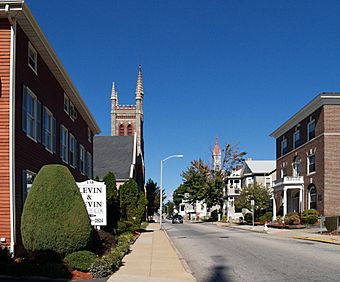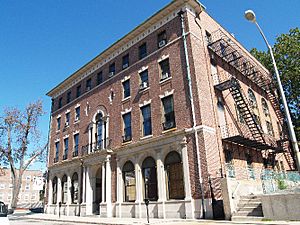Lower Highlands Historic District facts for kids
Quick facts for kids |
|
|
Lower Highlands Historic District
|
|

Rock Street
|
|
| Location | Roughly bounded by Cherry, Main, Winter, and Bank Sts., Fall River, Massachusetts |
|---|---|
| Area | 212 acres (86 ha) |
| Architectural style | Greek Revival, Late Victorian |
| MPS | Fall River MRA |
| NRHP reference No. | 84002171 |
| Added to NRHP | January 10, 1984 |
The Lower Highlands Historic District is a special area in Fall River, Massachusetts. It's one of the oldest neighborhoods where people lived. This district is found just east of downtown Fall River. It's also south of another historic area called the Highlands Historic District.
People started settling here around 1810. The buildings in this area show how the city grew. Fall River became a big center for factories and industry. This historic district was added to the National Register of Historic Places in 1984. This means it's a very important place to protect!
Contents
A Look Back: History of Lower Highlands
The Lower Highlands area has a long history. Even before European settlers arrived, Wampanoag Native Americans lived here. They settled along the banks of the Quequechan River. In the 1700s, English colonists laid out the main roads.
By the late 1700s, there were small mills in the Lower Highlands. These included grist mills (for grinding grain) and saw mills (for cutting wood). A small community of homes grew up nearby. In 1813, the city's first large textile mill was built. Textile mills are factories that make cloth. This mill was also on the Quequechan River.
North Main Street and Bedford Street became busy shopping areas. The neighborhood to their northeast became a place where many people lived. In 1843, a big fire destroyed much of the area. But the community quickly rebuilt it. Not much new building has happened since the early 1900s. That's when the city's economy started to slow down.
Exploring the District: What You'll See
The Lower Highlands district covers about 212 acres. That's like 212 football fields! It's roughly bordered by Cherry, Main, Winter, and Bank Streets. Most of its more than 100 buildings are homes. The oldest ones date back to 1810.
You can find some houses built in the Federal style. This was a popular style in the early 1800s. There are also many homes with Greek Revival features. This style uses ideas from ancient Greek buildings. Later in the 1800s, many multi-family homes were built. These were for workers in the city's factories. They often had simple styles popular at the time.
Some important non-home buildings are also here. The Church of the Ascension was built in 1875. It's a beautiful church in the Gothic Revival style. You can also see the Cataract Engine Company No. 3. This was a fire station built in 1843, right after the big fire.
Important Buildings in the District
Many buildings in the Lower Highlands are special. They are called "contributing properties." This means they help make the district historic.
Some examples of historic homes include:
- The Randall N. Durfee House (around 1896)
- The Elijah J. Kilburn House (around 1866)
- The Coggeshall House (around 1845)
Some important non-residential buildings are:
- The J.D. Hathaway Carpentry Shop (around 1845)
- The former Truesdale Clinic (1913)
- The Gee Building (1910)
- The Women's Union (1909)
Buildings with Their Own Historic Listings
Some buildings in the Lower Highlands are so important, they have their own separate listings. These are also on the National Register of Historic Places.
- Cataract Engine Company No. 3
- Church of the Ascension
- William C. Davol, Jr. House
- James D. Hathaway House




